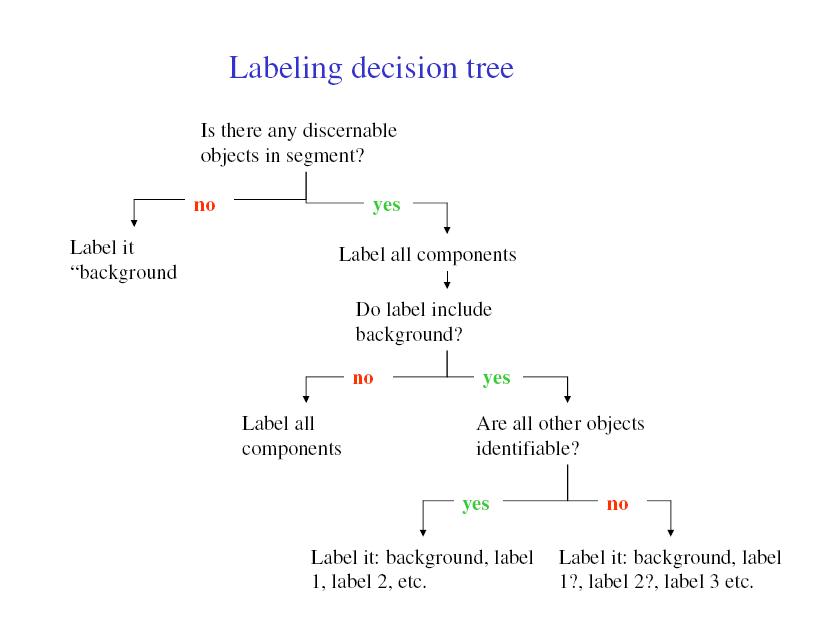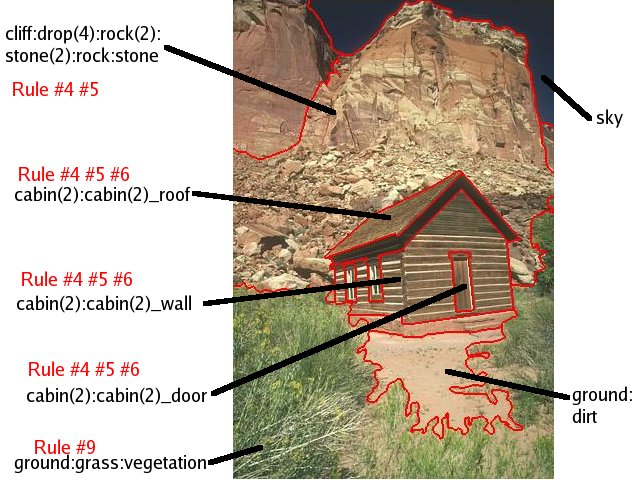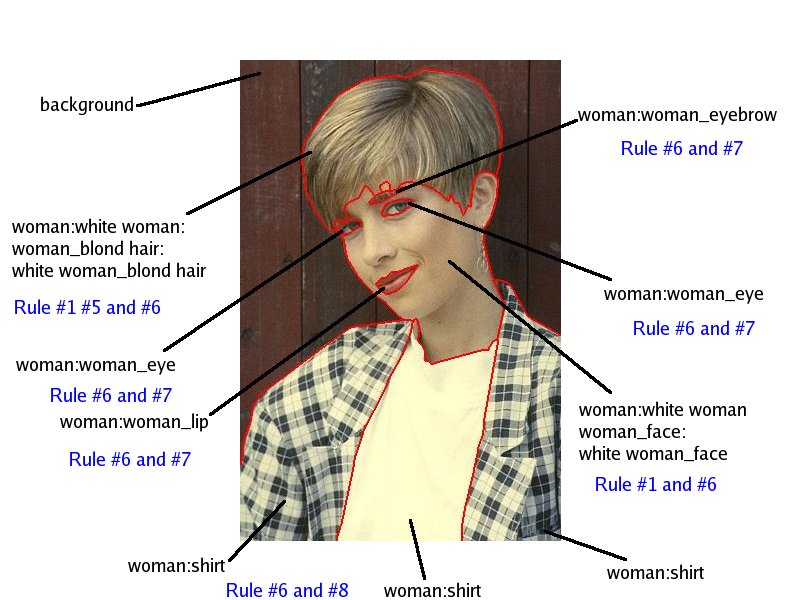1. Words
should
correspond to their wordnet definition.
2. Words should be lowercase.
3. Words should be singular.
4. The sense in wordnet (if multiple) should be represented as word(i), where i is the sense number in wordnet except if i=1.(e.g. tiger(2)).
5. The first synonym given in Wordnet is added as an additional entry.
6. Words that restrict to a part or class of an object should be word_type, like bobcat_head, the word itself should appear as another entry for that part(e.g. bobcat bobcat_head). It is not required to use this additional entry for labeling a part or class.
7. Wherever required the sense of the word should be incorporated in the part also (e.g. carriage(2) rig(6) carriage(2)_shelter(2)).
8. If a word is a compound word and another word can describe it as well add the single word (e.g. “birch tree”, birch). Care is taken to make sure this term is recognized in Wordnet.
9. If the same object can be described in a different way, but not necessarily as a synonym, label as is (e.g. grass, ground)
10. If no objects are discernable in a segment it will be called “background”.
11. If several objects are discernable in a segment, then all components will be labeled.
12. If an object cannot be recognized or a region is too small to be identified, it should be labelled as "unknown".
Rules 10 and 11 follow from the labeling decision tree shown below:
2. Words should be lowercase.
3. Words should be singular.
4. The sense in wordnet (if multiple) should be represented as word(i), where i is the sense number in wordnet except if i=1.(e.g. tiger(2)).
5. The first synonym given in Wordnet is added as an additional entry.
6. Words that restrict to a part or class of an object should be word_type, like bobcat_head, the word itself should appear as another entry for that part(e.g. bobcat bobcat_head). It is not required to use this additional entry for labeling a part or class.
7. Wherever required the sense of the word should be incorporated in the part also (e.g. carriage(2) rig(6) carriage(2)_shelter(2)).
8. If a word is a compound word and another word can describe it as well add the single word (e.g. “birch tree”, birch). Care is taken to make sure this term is recognized in Wordnet.
9. If the same object can be described in a different way, but not necessarily as a synonym, label as is (e.g. grass, ground)
10. If no objects are discernable in a segment it will be called “background”.
11. If several objects are discernable in a segment, then all components will be labeled.
12. If an object cannot be recognized or a region is too small to be identified, it should be labelled as "unknown".
Rules 10 and 11 follow from the labeling decision tree shown below:

Labeling decision tree
Some examples illustrating the rules are given below. Note that the rule numbers are with reference to the labeling rules mentioned above and that rule numbers one through five apply to all labels in general.
 Example image #1 illustrating some of the labeling rules. |
 Example image #2 illustrating some of the labeling rules. |
Rules for labeling humans
1) If
the skin color is obvious in the segment classify human as white,
black, asian.
2) If the origin or function is obvious by the clothing label as the clothing suggest (ex eskimo, south american, arab, soldier, skier, cowboy, etc.)
3) If a piece of clothing is selected in addition to label human label the part as the clothing (ex dress) or the clothing part (ex sleeve).
4) If the human is wearing an special gear in the segment label it (ex headdress, gloves, weapon, etc.)
5) If in the segment the hair color is obvious, label it (“blond hair”, “black hair”, “brown hair”, “red hair”, “white hair”)
6) Connect body part with human label (ex boy boy_face) but not clothes (ex boy pants).
7)
While
labeling parts of the human face, it is not required to mention skin
color for
parts such as eye, nose, mouth etc. The skin color should be mentioned
though (ex boy white boy boy_eye)2) If the origin or function is obvious by the clothing label as the clothing suggest (ex eskimo, south american, arab, soldier, skier, cowboy, etc.)
3) If a piece of clothing is selected in addition to label human label the part as the clothing (ex dress) or the clothing part (ex sleeve).
4) If the human is wearing an special gear in the segment label it (ex headdress, gloves, weapon, etc.)
5) If in the segment the hair color is obvious, label it (“blond hair”, “black hair”, “brown hair”, “red hair”, “white hair”)
6) Connect body part with human label (ex boy boy_face) but not clothes (ex boy pants).
8) If a garment worn by a human is to be labeled then skin color is not to be mentioned but the human is (ex boy sweater). 9) If a group of humans are present, they are collectively labeled as “people”. Individual human forms that are indistinct and are part of a scattered group of “people” are also labeled "people". 10) If an individual human is prominently displayed and the gender is indistinguishable due to excessive clothing or because only the back of the head is visible etc. the individual is labeled as “man”.
